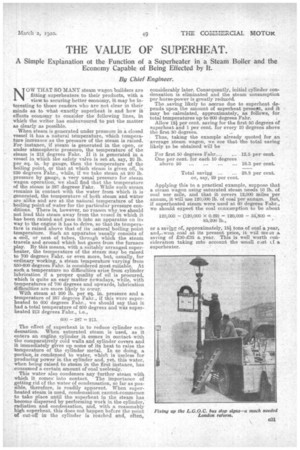THE VALUE OF SUPERHEAT.
Page 21

If you've noticed an error in this article please click here to report it so we can fix it.
A Simple Explanation ot the Function of a Superheater in a Steam Boiler and the Economy Capable of Being Effected by It.
By Chief Engineer.
NOW THAT SO MANY steam wagon builders are fitting superheaters, to their products, with a view to securing better economy, it may be interesting to those readers who are not clear in their minds as to what -exactly superheat is and how it effects economy to consider the following lines, in which the writer has endeavoured to put the matter
as clearly as possible. • .
When steam is generated under pressure in a closed vessel it has a natural temperature, which temperature increases as the pressure of the steam is raised. For instance, if steam. is generated. in the open, or under atmospheric pressure, the temperature of the steam is 212 degrees Fehr. If it is generated in a vessel in which the safety valve is set at, say, 20 lb. per eq. in. by gauge, then the temperature of the boiling point,_ or that at which steam. is given off, is 259 degrees Fehr., while, • if we take steam at 200 lb. pressure by gauge, a very usual pressure for steam wagon -operation, we shall find that the temperature of the steam is 387 degrees Fahr. While such steam remains in contact with the water from which it is generated, the temperature of both steam and water are alike and are at the natural temperature of the boiling point, of water for the particular pressure conditions. There is, however, no reason why we should i
not lead this steam away from the vessel n which it has been raised and. pass it into art apparatus on its way to the engine it has to drive, so that its temperature is raised. above that of its aatural boiling point temperature. Such an apparatus Usually consists of a coil, or nest of tubes, through which the steam travels and around which hot gases from the furnace play. By this means, with a suitably arranged superheater, the temperature of the steam. may be raised to 700 degrees Fehr. or even more, hut, usually, for ordinary working, a steam temperature varying from 550-600 degrees Fehr. is considered most suitable. At such a. temperature no difficulties arise from. cylinder lubrication if a proper quality of oil is procured, which is quite an easy matter no*adays, while, with temperatures of 700 degrees and upwards, lubrication difficulties are more likely to oe.eur. With steam at 200 lb. per sq. in. pressure and a temperature of 387 degrees Fahr., if this were superheated to 600 degrees Fahr., we should say; that it had a. total temperature of 600 degrees and was superheated 213 degrees Fahr., i.e.,
• . 600 — 387 = 213.
The effect of superheat is to reduce cylinder ecndensation. When, saturated. steam is used, as it enters. an engine cylinder it comes in contact-with the comparatively cold walls and cylinder covers and it immediately gives up some of its heat to raise the temperature of the cylinder metal. In se doing, a portion, is condensed to water, which is useless for producing power in the cylinder and, yet, this water, when being raised. to steam in the first instance, has :consumed a certain amount of coal uselessly.
This water also condenses any further steam with which it comes into contact. The importance of getting rid of the water of condensation, so fax as poesible, therefore, is readily apparent. When superheated steam is used, condensation cannot-commence to take Place until the superheat in the steam has become dispersed by performing work in the cylinder,' radiation and condensation, and, with a reasonably high superheat, this does not happen before the point of cut-off in the cylinder is reached and, often,
considerably later. Consequently, initial cylinder condensation is eliminated and the steam consumption per horse-power is greatly reduced. The ,saving likely to accrue due to superheat depends upon the amount of superheat present, and it may be calculated, approximately, as follows, for total temperatures up to 600 degrees Fahr.
Allow IA per cent. saving for the first 50 degrees of superheat and 1 per cent. for every 10 degrees above the first 50 degrees. Thus, taking the example already quoted. for an average steam wagon, we see that the total saving likely to be obtained will be For first 50 degrees Fehr.— 12.5 per-cent.
One per cent. for each 10 degrees above 50 ... ... 16.3 per cent.
• Total savieg ... 28.5 per cent. or, say, 29 per cent.
Applying this to a practical example, suppose that a steam wagon using saturated steam needs 10 lb. of coal Der mile, and that it covers 12,000 miles per annum, it will use 120;000 lb. of coal per annum. But,' if superheated steam were used at 60 degrees Fahr., we should expect the coal consumption to be about 120,000 — (120,000 X 0.29) = 120,000 — 34;800 = 85,200 lb.,
or a savier; of, a,ppreximateIy, 151 tons of coal a year, andiewitn coal at its present price, it will me lei a saving of 2304,35 a. year. This is well worth consideration taking into account the small cast LE a superheater.


































